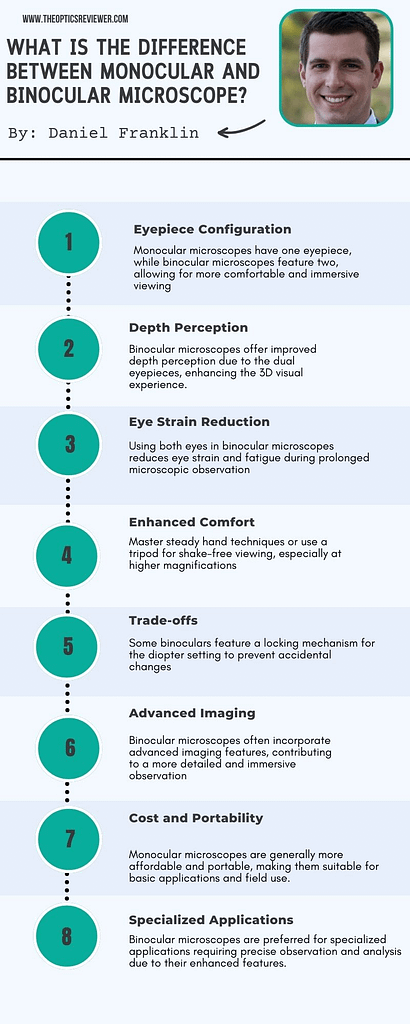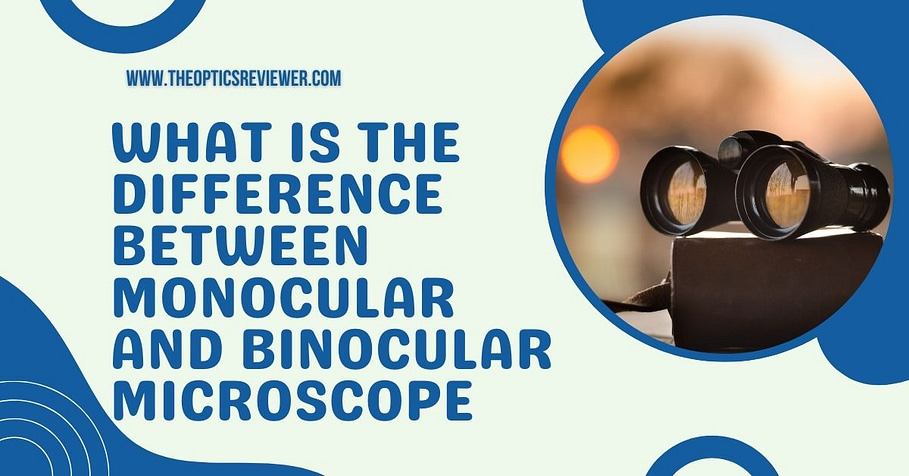Microscopes are invaluable tools in various fields of scientific research and analysis. They allow us to observe and study objects that are too small to be seen with the naked eye. When it comes to microscopes, there are different types available, each with its own set of features and benefits. One of the key distinctions is between monocular and binocular microscopes.
While both serve the same purpose of magnifying objects, they differ in terms of design and functionality. So, what is the difference between Monocular and Binocular microscope? Is one better than the other? In this discussion, we will explore the characteristics, advantages, and disadvantages of monocular and binocular microscopes, helping you understand which one may be the right choice for your specific needs.
Contents
- 1 Key Takeaways
- 2 What is a Monocular?
- 3 What is a Binocular?
- 4 What is the Difference Between Monocular and Binocular Microscope?
- 5 Monocular vs. Binocular Microscope, What to Choose?
- 6 What are the Uses of Monoculars and Binoculars?
- 7 Conclusion
- 8 References
- 9 Frequently Asked Questions
- 9.1 Can I Use a Monocular Microscope for Professional Laboratory Work?
- 9.2 Are Monocular Microscopes More Affordable Compared to Binocular Microscopes?
- 9.3 Can a Binocular Microscope Provide More Accurate and Detailed Observations Compared to a Monocular Microscope?
- 9.4 Are There Any Specific Industries or Fields Where a Monocular Microscope Is Preferred Over a Binocular Microscope?
- 9.5 Are There Any Specific Features or Specifications to Consider When Choosing Between a Monocular and Binocular Microscope for Hunting Purposes Under $200?
Key Takeaways
- Monocular microscopes have a single eyepiece, while binocular microscopes have two eyepieces for a stereoscopic view.
- Monocular microscopes are more compact, lightweight, and affordable compared to binocular microscopes.
- Monocular microscopes offer adjustable magnification levels and some models have built-in lighting systems.
- Binocular microscopes provide improved depth perception, immersive viewing experience, and higher magnification with a wider field of view. They are also preferred by professionals requiring these features.
What is a Monocular?
A monocular is a type of microscope that consists of a single eyepiece for viewing specimens. It is commonly used in various scientific fields, including biology, pathology, and research. The main advantage of a monocular microscope is its simplicity and ease of use. It is compact and lightweight, making it portable and convenient for fieldwork. Monocular microscopes also tend to be more affordable compared to their binocular counterparts.
However, there are some disadvantages to using a monocular microscope. The single eyepiece can cause eye strain and fatigue, especially during prolonged use. It also lacks the depth perception provided by binocular microscopes, which can be crucial for certain applications. Additionally, sharing observations with others can be challenging due to the absence of a second eyepiece.
Despite these limitations, monocular microscopes have several features that make them useful in various settings. They often come with adjustable magnification levels, allowing users to observe specimens at different scales. Some models also have built-in lighting systems, such as LED illumination, for enhanced visibility. Monocular microscopes are frequently employed in educational settings, where they serve as valuable tools for teaching and learning about microscopic organisms and structures.
What is a Binocular?
A binocular is an optical instrument designed for magnifying distant objects and providing a stereoscopic (three-dimensional) view. Binoculars consist of two identical telescopes mounted side by side, allowing the user to use both eyes simultaneously. This dual-telescope design enhances depth perception and provides a more immersive viewing experience.
Key components of binoculars include:
- Prism System: Binoculars use either roof prisms or Porro prisms to invert and revert the image, ensuring it appears right-side-up to the viewer.
- Magnification: Binoculars are labeled with two numbers, such as 8×42, where the first number represents the magnification (in this case, 8x) – indicating that the viewed object appears eight times closer than it does to the naked eye.
- Objective Lens Diameter: The second number in the label, like 8×42, denotes the diameter of the objective lenses in millimeters. Larger objective lenses allow more light to enter the binoculars, providing a brighter image.
- Field of View: This measurement represents the width of the area visible through the binoculars at a specific distance.
- Exit Pupil: The exit pupil is the diameter of the beam of light exiting the eyepiece and is crucial for brightness, especially in low-light conditions.
- Eye Relief: Eye relief is the distance from the eyepiece to the point where the user’s eye can see the entire field of view. It is important for comfortable viewing, especially for eyeglass wearers.
- Coatings: Binoculars often have coatings on the lenses to enhance light transmission, reduce glare, and improve overall image quality.
Binoculars find applications in various activities such as birdwatching, astronomy, sports events, hunting, and general outdoor observation. They come in a range of sizes and configurations to suit different needs, from compact models for portability to larger, more powerful binoculars for specific purposes.

What is the Difference Between Monocular and Binocular Microscope?
Microscopes play a pivotal role in scientific exploration and research, offering a closer look at the intricate details of microscopic specimens. When it comes to choosing a microscope, one of the fundamental decisions is between a monocular and a binocular design. Let’s delve into the key differences between these two types of microscopes.
Monocular Microscope:
A monocular microscope is equipped with a single eyepiece for observation. Here are some distinctive features:
Binocular Microscope:
A binocular microscope features two eyepieces, offering a more immersive viewing experience. Here are its key attributes:
Choosing the Right Microscope:
The choice between a monocular and binocular microscope depends on factors such as budget, user comfort, and intended application. For educational settings and introductory use, a monocular microscope may be a cost-effective and straightforward option. In contrast, professionals and those requiring prolonged use may prefer the enhanced comfort and depth perception offered by binocular microscopes. Understanding these differences allows users to make an informed decision based on their specific needs and preferences in the fascinating world of microscopy.

Monocular vs. Binocular Microscope, What to Choose?
When deciding between a monocular or binocular microscope, there are several factors to consider. Binocular microscopes offer the advantage of providing a more comfortable viewing experience, as they allow for both eyes to be used simultaneously. Additionally, binocular microscopes can enhance depth perception and provide a wider field of view.
On the other hand, monocular microscopes are often more affordable and compact, making them a suitable choice for those with limited space or budget constraints. Ultimately, the decision depends on the specific needs and preferences of the user.
Why Should You Choose Binocular Microscope?
Binocular microscopes offer numerous advantages over their monocular counterparts, making them the preferred choice for a variety of scientific and medical applications. Here are three reasons why you should choose binoculars:
- Improved Depth Perception: Binocular microscopes provide a stereoscopic view, allowing for better perception of depth and spatial relationships between objects. This is especially useful when conducting delicate procedures or analyzing complex structures.
- Reduced Eye Strain: With binocular microscopes, each eye can focus independently, reducing eye fatigue and strain during prolonged observations. This feature is particularly beneficial for researchers and healthcare professionals who spend long hours examining specimens.
- Enhanced Comfort: Binocular microscopes offer adjustable interpupillary distance and diopter settings, ensuring a comfortable viewing experience for users with different eye characteristics. This customizable feature allows for precise alignment of the optics to the user’s eyes, minimizing discomfort and maximizing clarity.
Why Should You Choose Monocular Microscope?
Choosing monocular microscopes offers unique benefits that make them a valuable option for certain scientific and medical applications. Monocular microscopes have several advantages over binocular microscopes. First, they are typically more affordable, making them a cost-effective choice for laboratories or educational institutions with budget constraints.
Additionally, monocular microscopes are generally lighter and more compact, allowing for greater portability and ease of use. They also tend to have a longer working distance, making them suitable for observing larger samples. However, monocular microscopes do have some disadvantages.
The single eyepiece can cause eye strain during prolonged use, and the lack of depth perception may be a limitation in certain applications. Overall, monocular microscopes are ideal for basic scientific and educational purposes, as well as fieldwork, where portability and affordability are important considerations.
If interested you can read more about what is field of view in binoculars.
What are the Uses of Monoculars and Binoculars?
The choice between a monocular and binocular microscope depends on the specific uses and requirements of the user. A monocular microscope is commonly used in educational settings, such as schools and colleges, for basic observations and demonstrations. On the other hand, a binocular microscope is preferred in professional laboratories, research facilities, and medical fields where higher magnification, accuracy, and comfort are necessary for detailed examination and analysis.
Monocular
Monoculars are versatile optical devices that provide a lightweight and portable solution for magnifying distant objects, making them ideal for travel and outdoor activities. Here are some specific uses of monoculars:
- Bird watching: Monoculars are perfect for birdwatchers as they allow for a close-up view of birds in their natural habitat. Their lightweight design makes them easy to carry during long walks in the wilderness.
- Stargazing: With a monocular, astronomy enthusiasts can observe celestial bodies and constellations with ease. Its compact size and high magnification power make it a convenient choice for stargazing.
- Hiking and outdoor adventures: Monoculars are a must-have tool for hikers and adventurers. They help in spotting landmarks, navigating through difficult terrains, and even observing wildlife from a safe distance.
In addition to these recreational purposes, monoculars also find applications in surveillance and security, providing a portable and discreet way to observe objects and activities from a distance.
If interested you can read more about are 80 x 80 binoculars good.
Binocular
When it comes to optical devices for magnifying distant objects, binoculars offer a different set of advantages and uses compared to monoculars. Binocular vision is the ability to perceive depth and three-dimensional space using both eyes simultaneously.
This is a key feature of binocular microscopes, which are widely used in various scientific and medical fields. Binocular microscopes provide a more comfortable viewing experience as they allow for a natural viewing posture with both eyes open. They also enhance depth perception, allowing for more accurate observations and measurements.
Additionally, binocular microscopes offer a wider field of view compared to monoculars, enabling users to observe larger areas at once. Overall, the binocular design of microscopes and binoculars provides numerous benefits that enhance the user’s visual experience and accuracy in scientific research and observation.
Conclusion
In conclusion of what is the difference between monocular and binocular microscope, the main difference between a monocular and binocular microscope lies in their viewing systems. While a monocular microscope utilizes a single eyepiece for observation, a binocular microscope offers the advantage of dual eyepieces, providing a more comfortable and immersive viewing experience.
This divergence in design significantly impacts ergonomics and depth perception, ultimately influencing the user’s overall efficiency and precision in microscopic exploration.
References
- https://link.springer.com/article/10.1007/BF00235723
- https://link.springer.com/article/10.1007/BF00233186
- https://link.springer.com/article/10.1007/BF00237700
- https://link.springer.com/article/10.1007/BF00248796
Frequently Asked Questions
Can I Use a Monocular Microscope for Professional Laboratory Work?
A monocular microscope can be used for professional laboratory work, but it has limitations. While it is advantageous in educational settings for its affordability and simplicity, it lacks depth perception and may cause eye strain and fatigue during long-term use.
Are Monocular Microscopes More Affordable Compared to Binocular Microscopes?
Monocular microscopes tend to be more affordable compared to binocular microscopes, making them a preferred choice in industries where cost is a significant factor. However, binocular microscopes offer better accuracy and are preferred in professional laboratory work.
Can a Binocular Microscope Provide More Accurate and Detailed Observations Compared to a Monocular Microscope?
A binocular microscope offers advantages in medical diagnostics, providing more accurate and detailed observations compared to a monocular microscope. The ergonomic benefits, improved depth perception, and superior image clarity make it a preferred choice in laboratory settings.
Are There Any Specific Industries or Fields Where a Monocular Microscope Is Preferred Over a Binocular Microscope?
In various industries and fields such as medical applications, educational settings, quality control in manufacturing, forensic analysis, and research in biology and genetics, a monocular microscope may be preferred over a binocular microscope.
Are There Any Specific Features or Specifications to Consider When Choosing Between a Monocular and Binocular Microscope for Hunting Purposes Under $200?
When choosing a hunting microscope under $200, it is important to consider affordable options, magnification requirements, durability, and portability features. These factors will ensure a suitable microscope for outdoor use.

